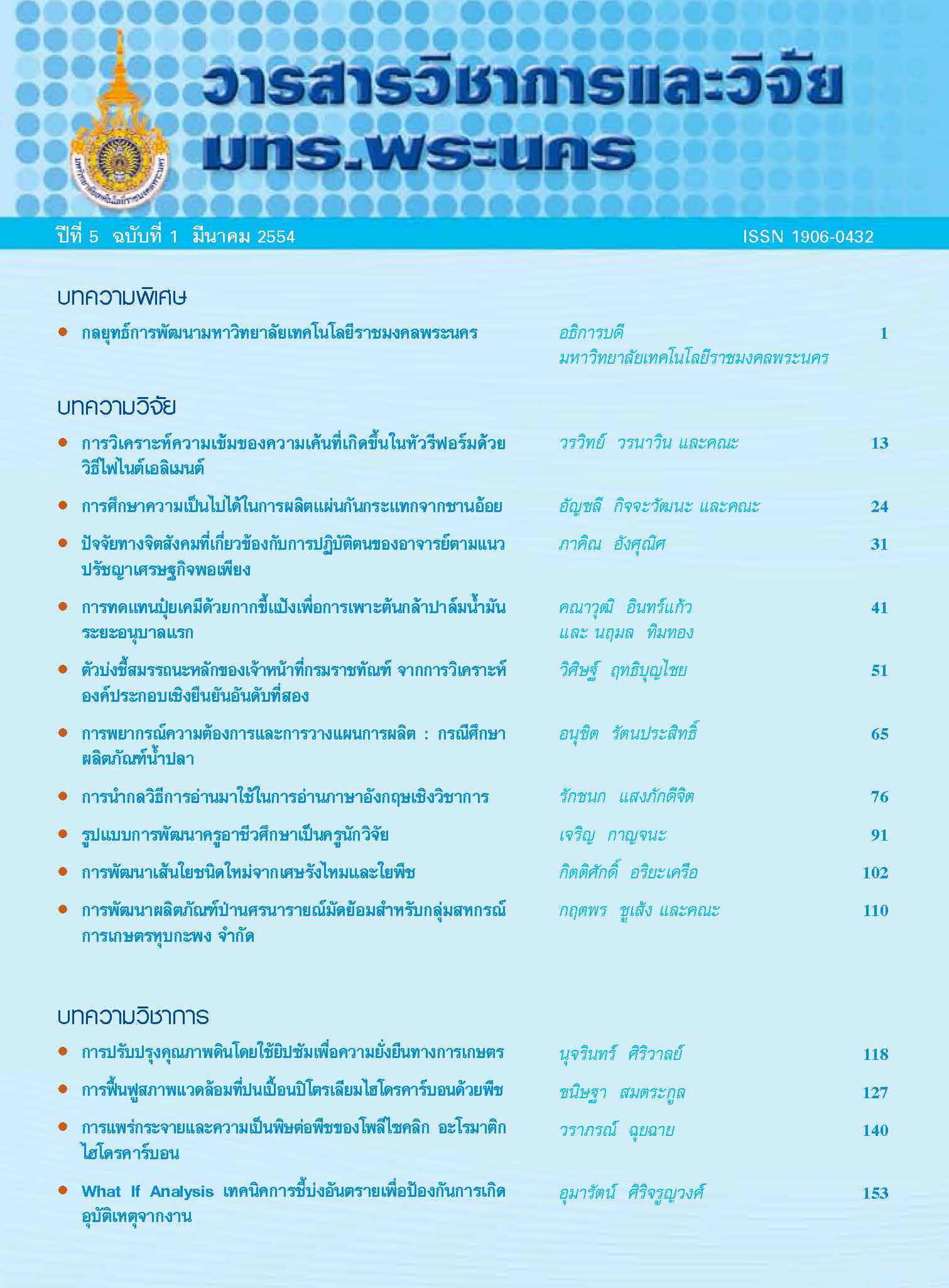การนำกลวิธีการอ่านมาใช้ในการอ่านภาษาอังกฤษเชิงวิชาการ
Main Article Content
Abstract
บทคัดย่อ
งานวิจัยครั้งนี้มีจุดมุ่งหมายเพื่อสำรวจกลวิธีที่นักศึกษาระดับปริญญาตรีใช้ในการพัฒนาทักษะในการอ่านเชิงวิชาการ บทความนี้นำเสนอในรูปแบบของการวิจัยเชิงคุณภาพ ซึ่งได้อธิบายการใช้กลวิธีในการอ่านเชิงวิชาการของนักศึกษาไว้อย่างชัดเจน ผู้วิจัยได้ทำการเก็บข้อมูลจากนักศึกษาคณะต่าง ๆ ของมหาวิทยาลัยขอนแก่น จำนวน 40 คน โดยการสัมภาษณ์ เทคนิค “open and axial coding” ได้นำมาใช้ในการวิเคราะห์ข้อมูลที่ได้จากการสัมภาษณ์ ผลการศึกษา พบว่า กลวิธีการอ่านที่นักศึกษาใช้ในการอ่านบทความทางวิชาการสามารถแบ่งออกได้เป็น 2 กลุ่มหลัก คือ 1) กลวิธีการอ่านเพื่อความเข้าใจ และ 2) กลวิธีเพิ่มพูนความเข้าใจในการอ่าน ซึ่งภายใต้ทั้งสองกลุ่มนั้น จะพบว่า มีกลวิธีการอ่านแยกย่อยได้ทั้งหมด 39 กลวิธี นอกจากนี้ ยังพบว่ากลวิธีการอ่านที่นักศึกษาใช้บ่อยที่สุดเป็นกลวิธีการอ่านที่อยู่ในกลุ่มกลวิธีการอ่านเพื่อความเข้าใจ ตัวอย่างของกลวิธีการอ่านเหล่านี้ เช่น การศึกษาความหมายของคำศัพท์ใหม่ ๆ ก่อนที่จะเริ่มอ่าน (BRC 1) และการหาความหมายของคำศัพท์ที่ไม่รู้จัก ที่พบในขณะที่อ่าน (WRC 1) ในทางตรงกันข้าม นักศึกษาจะไม่ได้ให้ความสำคัญกับกลวิธีการอ่านในกลุ่มกลวิธีเพิ่มพูนความเข้าใจในการอ่านมากนัก
คำสำคัญ : การอ่านเชิงวิชาการ; กลวิธีในการอ่าน; นักศึกษาระดับปริญญาตรี; การสำรวจเชิงคุณภาพ
Abstract
The purpose of this study was to investigate how Thai undergraduate students do toimprove their reading comprehension skills. This paper presents a qualitative investigation. Asemi-structured interview is served as the main source of data. Forty students from differentfaculties of Khon Kaen University participated in the study. The transcribed interview data wasanalyzed with ‘open and axial coding’ techniques. The data analyses revealed two mainemergent categories of reading strategies: 1) reading comprehension strategies (RC); and2) reading comprehension enhancement strategies (RCE) with altogether 39 individual readingstrategies. The interview result showed that the most frequently found strategies being reportedwere from the first category, e.g. looking for unfamiliar vocabulary items and then searching fortheir meanings before reading (BRC 1), and searching for the meanings of unfamiliar vocabularyitems while reading (WRC 1). On the contrary, the students reported not to rely heavily on thestrategies from the second category.
Keywords : Academic Reading; Reading Strategy; Undergraduate Students; QualitativeInvestigation


